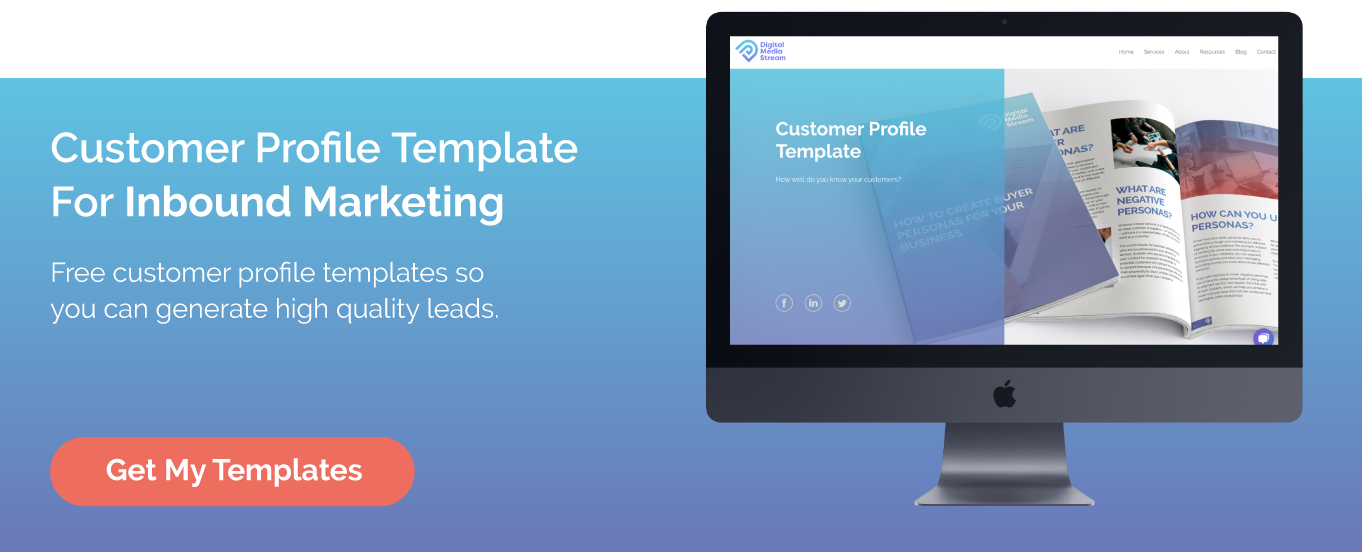Buyer Personas are semi-fictional representations of specific target audiences, constructed out of desktop research and real-world conversations with existing customers.
In business, Buyer Personas are used to model buying behaviour, giving a practical insight into how best to align marketing activities according to the target audiences preferences.
All you have to do is identify how many different buyer personas you have, and then investigate what problems they face that you as a brand are able to solve.
Think about your ideal customer; the person you have in mind when selling your product. Chances are you already know them!
You might think that hundreds of buyer personas are needed because for every buyer there is a different motivator, but from an Inbound Marketing perspective, you only need to focus on the most important ones.
It's not about selling to all the people you can possibly sell it to, it's really about focusing on the ones you want to sell to.
Why is a Buyer Persona important?
Establishing your buyer personas is top of the priority list for an effective digital marketing campaign.
It defines the ideal customer you are looking for and identifies their needs, pain points and purchase behaviour. This makes it easier for you to seek out similar customers, and easier for those customers to find you online.
Knowing your ideal buyer gives you a competitive marketing advantage: you can tailor your content to the specific interests, needs, obstacles, likes and dislikes of your target audience. You're able to create messaging that prioritises the customer and offers value at every touchpoint. In turn, this creates a brand experience that makes people want to keep doing business with you.
In short, a Buyer Persona narrows your focus to help you strategically plan your marketing activities in a way that attracts customers who meet your criteria.
Buyer Personas can help you to determine the following:
- The kind of content to produce
- Your content topics
- Content gaps
- Key messaging
- The style and tone of your content
- How buyers get their information and where they go
Knowing the importance of a buyer persona can often lead businesses to want to create multiple persona's. Often, what we do with the Buyer Persona examples is just as important as the persona creation exercise itself.
There is no set number of buyer personas your business should have. The key to creating truly useful buyer personas is ensuring that you are acknowledging all the different behaviours that result in purchases.
Analysing Your Business Niche
Your business might sell just one product in one market, or it could sell a single product across a number of different markets and sectors. Depending on what these sectors are, you might need to come up with different sets of marketing analytics to create your buyer personas.
For example: If you offer financial products then you will be covering every imaginable sector - from tech startups selling SaaS products to hotels, small businesses, large construction firms - and everything in between. The reasons for requiring finance can be many, as can the ideal buyer.
In this situation, you will discover there are many different buyer personas, each with different motivators, daily pain points, and varied job titles. Yet - each one still requires your services.
If your target audience is vast and varied like the example above, you can look for identifiers that each persona shares in common and use them to formulate your ideal buyer persona. You can also expand on each group individually - it comes down to preference.
Inversely - if you sell razor blades, then your buyer persona will be quite broad. People do not need to have a specific role to be interested in your product.
If your target audience is narrow as in this example, you'll need a more generic buyer persona that appeals to ideal customers more universally.
Taking a good look at your business niche will help you identify who you currently sell to, and what traits and motivators they reveal in their buying habits.
Your niche will also play a big role in determining how many unique buyer personas you need to create.
Everyone needs to start somewhere, though! Creating your first buyer persona can seem a mammoth task, but when you take a strategic approach and know what information to take note of it becomes far easier.
Creating Your First Buyer Persona
Your first buyer persona should be the most important one. What we mean by that is - it should focus on creating a profile of easily identifiable traits and behaviours of your ideal customer.
Rather than defining an individual, it should generalise the traits your customers all have in common and make it easier for you to identify these traits and use them to shape your marketing activities.
To identify the most important traits, consider asking some of these questions of your first buyer persona:
- What is the function of their role, not just their title. You can group more than one job title here, because more important is their job role. A financial director might make the decisions, but an accounts administrator will also experience similar day-to-day operational requirements. Once you know their function, you'll also understand their motivators, as well as their decision-making abilities.
- What does their typical day involve? Think about their aims and what tools they use during the course of their working day. You can also identify common or recurring challenges when asking this question. You'll be able to identify the areas they need support in and structure your "elevator pitch" in a way that illustrates the value you offer in a highly personalised way.
- What are their goals? Look into what they are trying to ultimately achieve in their position and what they value most about their job or company. What KPIs do they need to achieve? Do they have a vision for their role? When you tap into your customer's ambitions, you can market your brand as the vehicle to their success.
- What are the pain points? Everyone has difficulties and challenges that come with their role. Much of what we purchase is used to make our jobs or lives easier - or at least more convenient. If your brand can offer a solution that saves time, saves money, or enhances performance - make sure you're using that to illustrate value.
- Where do they go for solutions? With pain points comes complaints and a search for something better. Where have they been looking for answers until now? By identifying where your ideal customer seeks answers, you can make sure you're showing up there, too. Even the most well-thought-out marketing strategy can fall short if it's not present where the demand is. Find out where they are going, what they are saying, and finally - what they are doing about it.
There are some tried and tested best practice guidelines to help you navigate your way through, and to save some time, consider which questions you shouldn't be asking.
Can You Create Another Buyer Persona?
After going through the above list, do you have enough information to form a clear picture of another unique buyer persona you can sell to?
The key point to consider is how unique an additional profile would be. If you can create another profile with unique points and no duplication - then yes. If you find yourself repeating details with only one or two unique points, consider amending your initial buyer persona to include those details.
Remember: there are only so many 'ideal' customers you can have!
If you have a product or service that works on many levels and across many different sectors, creating more personas makes sense; you need to have a good understanding of many unique customers after all.
Only create additional buyer personas if you can form a clear picture of a unique customer, separately from your first buyer persona.
Identifying Your Best Customers
Sometimes, going forward means retracing our steps.
Think of the customers you already have; the loyal ones that make up the top 20% of your business. These are the customers you have already won over. So take some time to analyse what makes them your best customers.
In your analysis, you should be looking at what they buy from you and their reasons for doing so. You'll find this already forms the basis for a buyer persona and targeting people who match up to it is at the heart of all your buyer personas.
Real conversations with real customers often give businesses insights they would never have realised if they relied on desktop research. You should be aiming to uncover your existing customer's behaviours and traits so that you can identify and maximise your reach to new prospects who share the same traits.
We've found the 3 most pertinent questions to ask your existing customers:
-
- What goals have you achieved since working with us?
- What were you experiencing when you first decided to work with us?
- What made you decide to work with us?
Can You Have Too Many Personas?
After you have created your first buyer persona (and maybe your second), it might be tempting to keep narrowing down the list of attributes and buying behaviours. While tempting, sometimes fewer is better. Having too many personas can make it difficult to create enough unique content for each audience - and your lines will become blurred.
There should be distinct differences between each of the personas you have outlined. With different job roles and different industries often come different pain points, but you may find there is a lot of crossovers, too.
However, if you have analysed your data from successful leads and you can see clear differences in how they have reacted to your content, then it will clear the path to create more defined buyer personas.
Remember that buyer personas will naturally evolve over time. Rather than over-investing in the beginning, start with one buyer persona. You can always add on or create a new person as you get to know your audience better.
Changing & Adapting Your Buyer Personas
As we alluded to above, a buyer persona will never be a stagnant resource. The more information you gather, the more evolved your buyer persona will become. That means your marketing and content efforts become more aligned over time.
Feel free to amend, change or remove your buyer personas on an ongoing basis.
Buyer personas aren't about the prospects you could sell to; they are your ideal customers, the ones you are already selling to - and the ones you want to see more of.
You can create many buyer personas or just a few, but each should represent a different buying behaviour and you should be supporting each persona with the right content to encourage them along your sales funnel.
In Conclusion: This Is How Many Buyer Personas You Need
You need one buyer persona; your ideal customer. This is your 'master' template, the one that contains the details of the audience's behaviour, likes and dislikes, challenges, and goals.
Depending on your business niche, and how vast your audience is - you can choose to continue creating unique buyer personas for each persona.
All you have to do is identify how many different buyer personas you have, and then investigate what problems they face that you as a brand are able to solve.
Bear in mind that the more personas you create, the more content you'll need to create.
To help you get started on creating your first buyer persona, you can download our free template with guidelines and a handy blank canvas you can use to keep your persona research task efficient and practical.
We're always open to chat with you about your Inbound Marketing needs; book a free consultation with our digital experts, or request a callback today.



Export_Customer-profiles-buyer-personas.jpg?width=352&name=PP002-%20Images%20(880%20x%20495)Export_Customer-profiles-buyer-personas.jpg)
